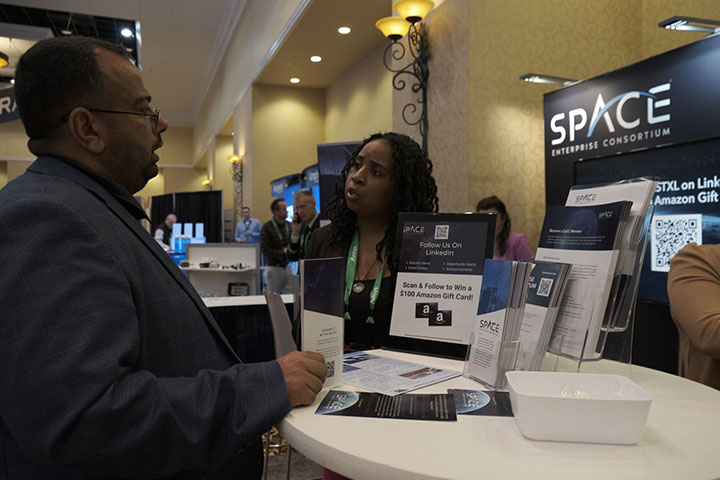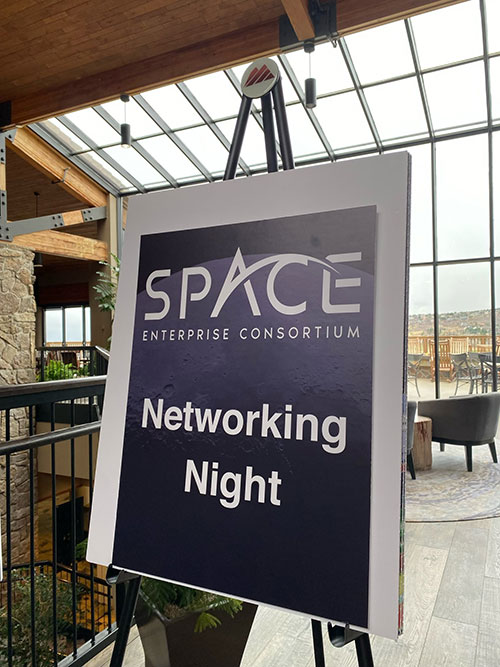ALEXANDRIA, Va. — Space startups seeking to do business with the Department of Defense often come up against a prohibitively high barrier to entry. Searching for opportunities, getting facetime with the right government contact and navigating industry relationships within a project can be overwhelming.
 SpEC personnel at a space industry trade show explaining their role in bridging the cultural gap between military buyers and commercial space startups. (Source: SpEC)
SpEC personnel at a space industry trade show explaining their role in bridging the cultural gap between military buyers and commercial space startups. (Source: SpEC)
The Space Enterprise Consortium (SpEC) was founded in 2017 to make it simpler for nontraditional defense contractors to work with the government to rapidly develop space technology prototypes through other transaction authorities (OTAs or OTs)—a more flexible vehicle than traditional government contracts or acquisitions.
Since it came under the management of the National Security Technology Accelerator (NSTXL) in 2021, SpEC has awarded around $1 billion in contracts per year, compared to $856 million in awards between 2017 and 2020. As a member organization made up of roughly 600 companies, SpEC’s day-to-day involves alerting members to new opportunities and ensuring they have the support to perform.
With the U.S. federal fiscal year winding down, SpEC Director JaNay Mills is anticipating a flood of requests from the government. The government will be reprogramming must-spend defense dollars and there will likely be several congressional adds for space technologies. Mills’ message to vendors ahead of the Oct. 1 end-of-year deadline: “Be ready.”
“This time of year is what I consider to be our busy season,” Mills said. Delays passing last year’s budget means programs are just now receiving funds and some have strong indications of funding for next year. As a result, the pipeline of OTA projects is filling quickly.
Several project opportunities will be announced in the coming weeks and months through SpEC. Notably, vendors should be prepared to respond to requests related to the Overhead Persistent Infrared Data Exploitation Technology Transition (OPIR ODETT), the Future Operationally Resilient Ground Evolution Command and Control (FORGE C2) and space domain awareness in general.
Companies with capabilities in those areas should be ready to respond “on a short fuse,” Mills added. SpEC will announce opportunities as soon as they are available and is ready to assist members in understanding solicitations.
Through the remainder of the year, the greatest need will be software integration for existing prototypes. Recently, a draft request for prototype proposal (RPP) was issued for ground software integration for FORGE C2, the next-generation ground system for OPIR missile warning capability. Similarly, requests for software elements for other programs will likely be released in the summer with additional announcements forthcoming.
“This is turning out to be the year of software,” Mills said, noting an alternating trend in Space System Command’s demand for hardware one year and software the next. SSC will be leaning on industry to fulfill that need for software integration expertise.
Transitioning from Prototype to Production
While SSC is the primary owner of the SpEC vehicle, it can be used by any U.S. military or intelligence agency that needs a space prototype. Both the Air Force Research Lab and Missile Defense Agency have utilized SpEC to prototype projects in their space portfolios; and with a $12 billion cap over 10 years, SpEC appears to be equipped to meet joint force demand for mission-critical space tech prototypes.
Unlike traditional Federal Acquisition Regulations (FAR) contracts, SpEC’s ability to issue OTA contracts cuts the time between solicitation and the start of performance to around 90 days. Most requests for proposal are out for 30 – 45 days max. If the government team uses a nonstandard evaluation process, it can be a matter of weeks before a company can begin work on a prototype.
 SpEC hosts various networking events around the country and facilitates face-to-face meetings to connect vendors and government space tech buyers. (Source: SpEC)
SpEC hosts various networking events around the country and facilitates face-to-face meetings to connect vendors and government space tech buyers. (Source: SpEC)
The main requirements to qualify for an OTA contract are for a company to be either a nontraditional defense contractor serving as a prime or a large company with a nontraditional defense contractor performing “to a significant extent” on the project.
Awarding OTA contracts to small businesses and those that have not worked with DoD previously, the government helps improve the strength and resilience of the space industrial base, according to Mills. It also allows the government to benefit from the agility of nontraditional contractors.
“They’re able to fail fast, recover and create the collaboration that’s needed with the government to understand [whether what they’re providing is] meeting the mark,” she continued. Small innovators tend to be more flexible and can adjust as project requirements change.
The approach has led to several success stories—or success stories in the making. The Satcom Enterprise Management and Control (EM&C) is one example where nontraditionals won four out of six of the original SpEC awards. Three of those nontraditionals have continued advancing the prototype and received new funding. The satcom EM&C project falls under the broader vision of establishing, operating and monitoring a seamless, hybrid military-commercial satcom network.
MeshONE-T is another example of a prototype solicited through SpEC, which has undergone testing and is likely on its way to production. Sev1Tech received an initial $46.5 million OTA contract to prototype a data transport-as-a-service capability for the ground component of the meshONE battle network concept. The ultimate vision is to link air, land and sea operations through high bandwidth communications and edge connectivity. Sev1Tech is reportedly in early conversations about a possible production contract.
In the last two years, at least three SpEC prototypes were awarded additional contracts, according to Mills. At least two of those prototypes are expected to go into production, if budget requests are met.
Other SpEC awardees from 2017 – 2020 have reportedly transitioned into production, but NXSTL has limited access to the early version of the program. Tracking the progress of OTA prototypes is one particular area where SpEC aims to improve and is working with the government and contract performers to enhance visibility.
Ultimately, the long-term success of the vehicle will depend on both government and industry improving their understanding of OTA as a tool to unleash rapid prototyping capabilities. It will also depend on SpEC’s ability to creatively foster opportunities to bring together commercial innovators and government requirement developers.
“This vehicle is primed to change how OTs are utilized and truly rapidly…getting that end prototype into production and into the hands of the government and warfighter,” Mills said. “We can move as fast as they allow us to move.”
Explore More:
Podcast: The AFRL Exchange Program, Aligning Military and Commercial Needs
Space Force Taps Universities for 5 Areas of Collaborative Research, Prototyping
Podcast: Intentional Collaboration, Asking the Right Questions and Turning the Ship Around
‘Technology Is Not Enough’: Saltzman Addresses Industry’s Role in Force Readiness
